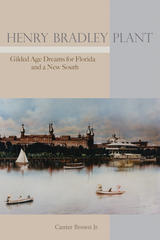

The oldest town in interior south Florida, Fort Meade lies about 50 miles east of Tampa and 10 miles south of Polk County's seat of Bartow. In this volume, Polk County native Canter Brown recounts the intriguing story of the founding and evolution of Fort Meade during the last half of the 19th century, when it was first established as a military outpost to separate Seminoles from white pioneer families desirous of cattle-grazing lands. A civilian community coalesced at Fort Meade under the pressures of the Billy Bowlegs War of 1855-58. Quickly the village developed as a cattle-industry center, which was important to the Confederacy until its destruction in 1864 by home-grown Union forces.
In the postwar era the cattle industry revived, and the community prospered. The railroads arrived in the 1880s, bringing new settlers, and the village grew into a town. Opportunities expanded as well with the growth of citrus, phosphate mining, truck farming, and tobacco industries. A boom-and-bust economy alternately bolstered and rocked the town, and the disastrous freezes of 1894Ð95 almost delivered a fatal blow.
Little has been written about town development on the Florida frontier. This book portrays the extremely complicated and often exciting processes and influences at play in interior south Florida, and the very precarious hold that town life possessed on that frontier.Local history the way it should be written. Canter Brown has managed to score several significant accomplishments in Fort Meade, 1849-1900. The book contributes to the growing body of good, solid monographs dealing with Florida state and local history and represents the building blocks necessary for a state and regional synthesis. The cumulative research compiled for this volume is impressive and daunting. Canter Brown proves that good local history requires considerable detective work and far-ranging inquiries.

In this landmark biography, Canter Brown Jr. makes evident the extent of Henry Bradley Plant’s influences throughout North, Central, and South America as well as his role in the emergence of integrated transportation and a national tourism system. One of the preeminent historians of Florida, Brown brings this important but understudied figure in American history to the foreground.
Henry Bradley Plant: Gilded Age Dreams for Florida and a New South carefully examines the complicated years of adventure and activity that marked Plant’s existence, from his birth in Connecticut in 1819 to his somewhat mysterious death in New York City in 1899. Brown illuminates Plant’s vision and perspectives for the state of Florida and the country as a whole and traces many of his influences back to events from his childhood and early adulthood. The book also elaborates on Plant’s controversial Civil War relationships and his utilization of wartime earnings in the postwar era to invest in the bankrupt Southern rail lines. With the success of his businesses such as the Southern Express Company and the Tampa Bay Hotel, Plant transformed Florida into a hub for trade and tourism—traits we still recognize in the Florida of today.
This thoroughly researched biography fills important gaps in Florida’s social and economic history and sheds light on a historical figure to an extent never previously undertaken or sufficiently appreciated. Both informative and innovative, Brown’s volume will be a valuable resource for scholars and general readers interested in Southern history, business history, Civil War–era history, and transportation history.
READERS
Browse our collection.
PUBLISHERS
See BiblioVault's publisher services.
STUDENT SERVICES
Files for college accessibility offices.
UChicago Accessibility Resources
home | accessibility | search | about | contact us
BiblioVault ® 2001 - 2024
The University of Chicago Press









